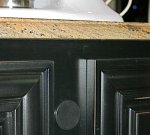I have no grudge against you, but I do think your concept would not satisfy the code requirements. The reason is that the overhang is measured to the "support base." The corbel you offer as a solution is not the base that is supporting the weight of the countertop. Depending on its method of attachment, it might carry some share of the load. But if you remove the corbel, the countertop's weight will still be carried by the base cabinetry. By contrast, if you tried to remove the base cabinetry and leave only the corbel, there would be no support for the weight of the countertop. From this I infer that the code language is addressing the distance from the edge of the countertop to the face of the base cabinetry. What makes that easier for me to believe is my earlier discussion about putting bar stools under the overhang.



